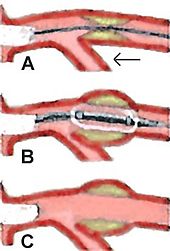Snow plow phenomenon
The term snow plow phenomenon (after English snow plow effect ) is used in medicine by cardiologists for a possible complication in balloon dilatations (PTCA, percutaneous transluminal coronary angioplasty). It describes the undesirable impairment of neighboring blood vessels during and after balloon dilatation for the treatment of narrowing of the coronary arteries .
The snow plow phenomenon can occur in the treatment of vascular constrictions if these are located in the area where the branches branch off (bifurcation) . In particular, if the exit area itself is narrowed (bifurcation stenosis ) , parts of the expanded wall deposits (the so-called plaque ) can narrow the side branch ( stenosis ) or even close it ( occlusion ) . This effect is comparable to a snow plow , which clears the streets but clogs side streets with snow.
Various techniques or "tricks" are used to avoid the snow plow phenomenon:
- the "two-wire technique", in which a second guide wire is inserted into the side branch as a precaution so that it can also be dilated if necessary,
- the "kissing balloon technique", in which a second dilation balloon is placed in the side branch and inflated at the same time,
- the atherectomy of the stenosis with the aim of not pushing the plaque material aside, but removing it and
- the use of stents with a particularly wide mesh, which facilitate subsequent probing of the side branch.
Overall, however, balloon dilatation of bifurcation stenoses remains at a slightly higher risk, so that in some cases balloon dilatation is rather avoided and bypass surgery is recommended instead .
Web links
- Interventional therapy of CHD ( Memento from May 24, 2010 in the Internet Archive )
